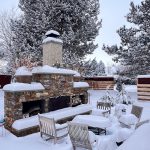

CREATING EUROPEAN GARDEN STYLE
Creating your own mini Versailles is much more achievable than you might think. A small formal garden area can be right at home within a more naturalistic residential setting. Elements of a formal garden can be integrated around a patio, paths, or an outdoor living space. While many gardens remain true to the basics of a formal landscape design, traditional and specific rules need not be followed to create a pleasing effect. For instance, the feeling of a formal garden can be created using statuary, a fountain, bench, or other focal point with symmetrical plantings at the end of a walk or other strategically positioned location. A pair of classic urns with identical plantings either side of a gate or doorway lends a sense of the formal garden. Classic column designs for an arbor or other structure also contribute formality to a scene.

Design of a traditional formal garden is a study in geometry and for the greatest success does require reasonable precision in planning and installation. The plan can be actually somewhat simple in general layout. Formal and parterre gardens are generally arranged on flat ground along intersecting axis lines and are traditionally rectangular or square. They are frequently subdivided into quadrants depending on the amount of space available. As an alternative plan, the overall shape may be modified to form a circle, hexagon, or octagon. Repeated geometric forms, known as arabesque, are commonly used. For maximum visual effectiveness, the interlacing, rhythmic, and sometimes elaborate patterns should be clearly recognizable and proportional to the design in total and the context.
PLANTS, MATERIALS, and ACCENTS
Plants are generally chosen from species and cultivars that are slow-growing, petite at maturity, have small leaves, and respond well to trimming and tip pruning. Various herbs are frequently used, creating wonderful scents in the garden. Ground covers en masse or stone pebbles are effective textural effects. Repetition is key to the design concept; therefore, the variety of plants in a formal garden is typically limited.

Barberry contrasting foliage. Photo from Monrovia.com
Plants and shrubs ideally will be a tapestry of deciduous and evergreen selections with contrasting textures, foliage color, and shades of green. Seasonal color and interest can be achieved with annuals, bulbs, and selective and classic herbaceous perennials such as peonies and Lenten rose. A favorite pairing of mine for color variety is Barberry Berberis thunbergii ‘Crimson Pygmy’ (burgundy foliage) and ‘Sunjoy™ Gold Beret’ (golden foliage) or ‘Monlers’ Golden Nugget. Combined with evergreens, they create beautiful contrast of foliage. It is important to keep accurate records of all plants and cultivars so the composition maintains integrity through the years as a plant here or there needs to be replaced.

This two acre landscape design incorporates formal features and geometry while also integrating informal casualness, bringing the best of both together!
Classic materials for walks are brick, stone, and fine gravel. Alternatively, pine tags (straw) or fine mulch may be used. Pathways should be four feet wide or larger for two people to pass, and two to three feet wide for secondary paths or a smaller garden. A hardscape surface will encourage a faster gait while fine gravel or soft materials slow down the pace. More common in England, a grass path is a lovely alternative and connects the formal garden visually with a surrounding lawn. Whatever the choice, it’s important for safety to install level paths of a slip- resistant material. No pea gravel should be used as it is unstable and awkward to walk on. For a feeling of permanence and ease of maintenance along paths and perimeters, consider edging with brick or cobblestone. Classic designs in statuary and furniture complete the composition.
Read The Timeless Garden, part 1
Related posts:
No related posts.
Tags: historic design, Landscape design
Leave a Reply Cancel reply

More Story
THE TIMELESS GARDEN
As we celebrate historic garden week in central Virginia, I thought it fitting to focus on formal gardens. Gardens on the tour...Subscribe to the Blog
Site Menu
Recent Posts
- What's a gardener to do... in winter?
Jan 22, 2024 - New Year, New Plans!
Jan 1, 2024 - The Thoughtful Host
Dec 7, 2023
- What's a gardener to do... in winter?

You may link to a post or take quotes if credit, including a link back, is given.
You may not take entire posts or photographs without asking.
Permission may be requested using the contact form .












Share On